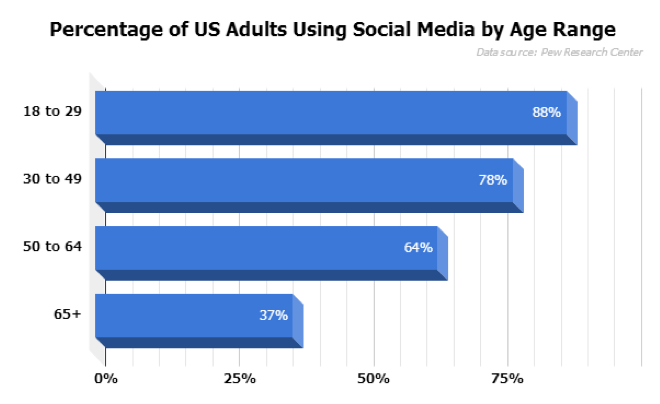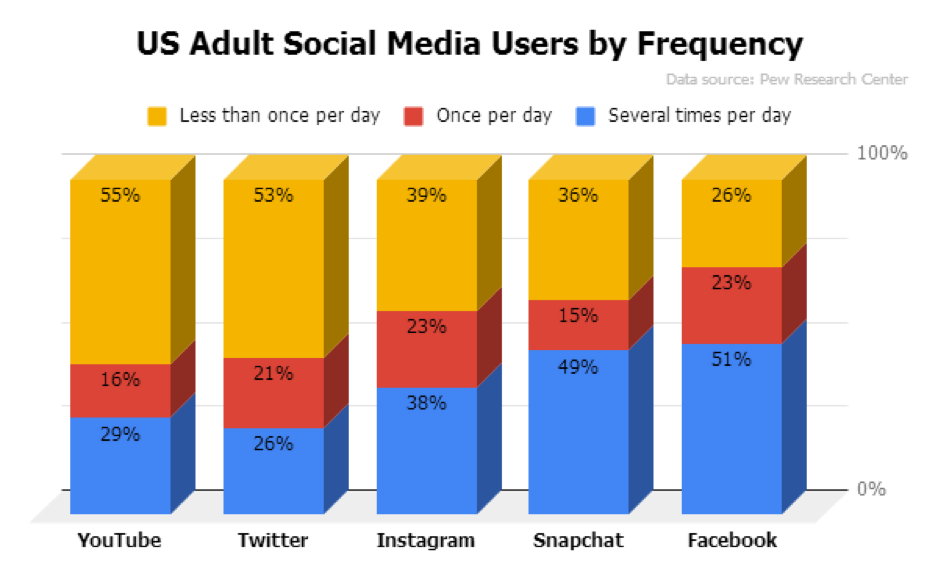Learn The Social Media Language
The importance of an active social media presence has risen from meh to mission-critical over the past decade. With social media use projected to eclipse 3 billion users worldwide by 2021, it’s become necessary for business owners to learn the language of social media marketing.
Social-speak, like many languages, varies by location. What works in one place, won’t necessarily work in another.
Learning the basics of social media marketing helps you:
- Drive organic traffic to your site
- Provide leads for your sales funnel
- Grow brand or product awareness
- Foster customer interaction
Social media marketing isn’t as simple as writing posts for your followers. It involves much more than that, but the payoff can be substantial for:
- Local business owners
- B2B and B2C companies
- Writers and authors
- Freelancers
- Consultants
- Service providers
- Merchants
Table of Contents
Social Media Marketing Topics
By reading this guide, you’ll find insightful answers to questions like:
- Who uses social media?
- How does social media marketing help businesses?
- Is social media effective for local business?
- What’s targeted advertising?
- What’s content marketing?
- What’s a social media marketing audit?
- Why are goals important?
- What is an editorial calendar?
- What are some best practices for posting?
- What are niche sites?
- How do you measure success?
- Are there tools available to help?
Social Media Platforms And Demographics
There are many social media sites. While some are similar, others are unique in their culture and format. For a successful campaign, knowing their characteristics and using those that best represent your ideal customer is crucial.
This guide teaches simple ways to grow and speak to your audience on sites like:
- Snapchat
- YouTube
Just Pinned to Marketing: I share my top 10 marketing strategies to drive traffic and get more sales! Social Media Marketing is actually so straight forward, it is not difficult. I hope you enjoy the tips xx female entrepreneur // coaching // life co… https://t.co/6yJL7TZLqm pic.twitter.com/7lLIgrjm8Q
— Shawn Winkler-Rios (@Soloprenur) December 1, 2018
What Age Group Uses Social Media?
Usage and demographics vary by platform. Understanding this information and how it relates to your business gives you a competitive advantage.
A recent study by the Pew Research Center illustrates social media’s increasing role in everyday life.

Nearly 90 percent of Americans age 18 to 29 and about 80 percent of those age 30 to 49 use social media.
There’s little doubt that your current and potential customers are using social media right now.
What’s more telling is the frequency of use and number of social media channels that Americans use. Three-quarters of all Facebook users are active at least once per day. More than half report being on several times per day.

Did you know:
- Half of Americans with a college degree use LinkedIn. Only nine percent with a high-school education or less have profiles.
- Pinterest has 2.5 times more female than male users.
- WhatsApp reaches 49 percent of US Hispanics, but just 21 percent of black and 14 percent of white Americans.
- Three-quarters of active social media users interact on multiple platforms; most have 3 or 4 profiles.
- Since 2014, the percentage of people claiming they’d have a hard time giving up social media has risen from 28 to 40 percent.
It’s clear. Social media audiences are broad and engaged. Fortunately, there’s a wealth of information and tools available to help you locate and interact with your ideal customers.
How Does Social Media Marketing Help Your Business?
Traditional print, radio, and TV advertising help businesses grow by casting a wide net to a broad audience. You can’t interact with them and it’s very costly to adjust strategy mid-campaign.
What if you could reach just as broad an audience, while fine-tuning delivery with geographic, demographic and behavioral parameters?
Targeted Ads
Targeted ads deliver specific content to users most likely to fit your ideal customer profile (ICP). Here’s the kicker: you only pay for the ones that click.
Some platforms have thousands of data points letting you narrow your audience by factors like:
- Geography: you can target areas as small as your town.
- Demographics: age range, income, gender, education and more.
- Interests: target leads based on hobbies, pages liked or activities.
- Behaviors: locate leads based on factors like digital activities, consumer classification, and device type.
Targeting improves the odds of your ad converting. It also makes it less likely that low-converting leads see your ad, which saves you money.
Social media is a low-cost, high-potential medium. With global spending increasing by billions each year, it’s apparently working.
What About Local Businesses?
Most people search Google when they need a service or product now. Social media works differently.
With Google, you’re presenting your business to someone with a need. Through social media, you attract new customers with offers while nurturing existing ones with content.
An active social media presence works hand in hand with your search engine marketing efforts.
Try this: To demonstrate the potential of targeted ads, give this simple experiment a try:
- Collect email addresses or encourage in-store customers to like your Facebook page. You’ll need at least 100. Tip: try using QR codes at your location; they’ve got some interesting new features.
- Combine these emails and page likes into a custom audience on Facebook.
- Use Facebook’s Lookalike tool. Lookalike analyzes these profiles, looking for similarities, then delivers a targeted group of similar profiles.
- Create a pay-per-click (PPC) coupon campaign aimed at this Lookalike audience. Don’t be shy; 10 percent off is nice, but 25 is better for attracting new business. Giving away something useful for free works wonders, too. Be creative.
- Track your click-through rate (CTR) and redeemed coupons.
- Make adjustments, add more profiles and try again. Compare your results to the first attempt.
Now that you’ve got a collection of likes and email addresses, you can start marketing to that group as well. Try a different offer for them, or give them some useful, relevant content. Let them know you remember them.
This is only the beginning; there are many ways local businesses use social media.
Using Social Media to Grow Traffic and Gain New Leads
While targeted ads boost your conversion rate, organic posts engage your customers and attract new ones.
GlobalWebIndex, a consumer-data tech company, publishes data from 70,000+ participants on their reasons for using social media. They periodically post the top ten. Here are some of the more interesting ones:
- To find entertaining content. 37 percent listed this as one of their top reasons, up 3 percent from the prior report.
- To research or find products. 29 percent, up 2 percent from the prior report.
- To stay up to date with news/current affairs. 41 percent, up 2 percent.
- To share my opinion. 30 percent, no change.
- Fill up spare time. 39 percent, no change.
You’ll have a hard time finding a business or writer that can’t make use out of at least a few of those behaviors. Social media isn’t only about keeping up with friends and family or posting pictures. Social media users, by the millions, are there for knowledge and entertainment.
The majority of them aren’t interested in your product or service. You don’t need their interest. You only need to attract your perfect customers.
Chances are, your perfect customer wants your valuable information or entertaining content. So, give it to them.
What is Content Marketing?
Well-planned content marketing goes a long way. Master this, and you might not need a marketing budget at all.
Content is a broad term. When it comes to sharing content through a social channel, it could be:
- Images and videos
- Blog posts and white papers
- Recipes
- Case studies and product reviews
- Podcasts
- How-to guides and e-books
- Industry news
- Surveys and contests
Content marketing is a systematic method of producing engaging content and releasing it according to a schedule. The goal is to capture a viewer’s attention, engage with them and guide them toward business objectives.
Providing useful content helps to build brand loyalty for existing customers. It also increases the likelihood that they share the content, enabling you to reach new customers with a personal seal of approval from someone they know.
Get Started
There’s a lot involved with a creating strong social media campaigns. Whether you choose professional help or handle things internally, follow these best practices.
The Ultimate Guide to Social Media Marketing Campaigns- learn how to reach customers, increase web traffic and drive sales https://t.co/Hm2z9AUyII @hubspot #socialmediamarketing #digitalmarketing #smallbiz #Entrepreneur
— Gold Mango Design (@goldmangodesign) October 3, 2018
Perform a Social Media Marketing Audit
A social media marketing audit:
- Evaluates your profiles, content and landing pages, so they’re optimized to convert traffic
- Makes sure all information is up to date and consistent across your platforms
- Measures engagement and success of current strategies
- Analyzes your competitor’s activity to identify opportunities
You can find many different free audit templates online.
Set Goals And Make a Plan
Don’t jump in before setting reasonable goals. As with any business or marketing strategy, measurable goals are a fundamental necessity. Be specific with your goals; there are many ways to measure.
Your goals help determine the strategy and tactics used to achieve them.
- If your goal is to provide 20 percent more leads to your sales funnel, then you’re going to need more top-of-funnel (TOFU) content.
- If you’re looking to increase in-store sales by 10 percent, try coupons and targeted ads.
- Want more shares and backlinks? Create entertaining or authoritative content.
- Looking to sell or market your book? Write shorter, related content and share it organically.
Decide what you want to accomplish and put together a plan to achieve those goals. Some businesses plan monthly or quarterly, while others map out their entire year. Your plan will help you to identify your content needs.
Use an Editorial Calendar
Editorial calendars are exactly what they sound like. Using one helps you to manage content creation and schedule upcoming posts. You’ll find no shortage of free templates to get you going.
Post Properly
Having great content does no good if you can’t get anyone to stop scrolling. Take the time to learn the culture within each platform that you use. What gets attention on Facebook may not be well-received on Twitter.
Follow these tips:
- Keep it short and sweet. Let your content and landing pages do the talking for you. Your post should grab the viewer’s attention and entice them to open your content in a matter of seconds. Even though some platforms give you all the room you need, you shouldn’t use it.
- Use images; even for written content. Images convey information and emotion far more quickly than words. When using sites like Instagram and Pinterest, it’s all about the image.
- Tease your audience. Focus on the benefits of the content, not the content itself.
- Watch your hashtags. Tweets with hashtags get twice the interaction as those without. User interaction with posts containing one or two hashtags is higher than those with three or more. The opposite is true of Instagram where posts with 6 to 8 hashtags perform better than those with fewer. Don’t skip the hashtags; they help attract new viewers.
- Include a call to action (CTA). It should be visible without requiring interaction with the post. Create urgency and direct your audience to engage.
- Interact with your audience. If they’re commenting, so should you. When commenting, speak with the tone and personality of your business. Be confident, inclusive and helpful. It doesn’t hurt to be funny, too.
- Use native advertising techniques. Native advertising is advertising that looks like it belongs to the organic content typically shared on the site. Learn the culture and use it to increase interaction.
Don’t Forget the Little Guys
There’s plenty of leads on the major social sites, but don’t forget to check out the smaller ones that are relevant to your market. Social media is any site where registered users share content.
Find out where people in your market spend their time. Performing customer surveys is an excellent way to discover other sites that they use. If your current customers are there, chances are potential customers are, too.
How to Use Social Media to Promote Your Business and Drive Traffic to Your Website
The measure, Adjust and Try Again
As you progress through campaigns, you’ll notice trends in performance. You may find that your average ad has a two percent CTR while your landing pages convert at nine percent.
You’ll also find overachievers and underperformers. Study these instances and try to identify what is making them work, or why they’re lagging behind. Make adjustments, try again and remeasure. Even minor changes can impact your conversion rates.
This is optimizing your campaign, and it’s a key component of any digital marketing strategy.
Get Help
There are tools available to help you learn the ropes and manage your social media marketing endeavors.
Here’s a few to get you started:
- Facebook Pixel allows you to put the code on your pages to track traffic from Facebook ads. The data it collects helps you optimize ads and pages to convert. It can also help build custom audiences.
- Social media dashboards, like Hootsuite and Buffer, let you manage cross-platform campaigns from one place. Most include useful analytic tools.
- Sites like Grammarly and Hemingway can help you craft well-written content.
Whatever your plan, arm yourself with as much information and data as possible. Remember, social media marketing is a significant advertising platform; approach with care and creativity.
Adazing believes every business should know how to navigate the digital marketing seas. For those that don’t have the time, we’re here to help. Let’s talk about your social media marketing strategy now.
Read Next Article: “How to Write a Cliffhanger” is locked







